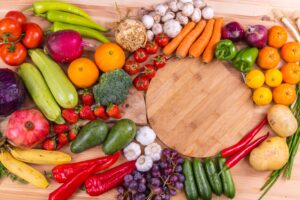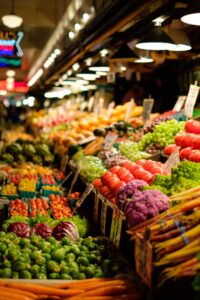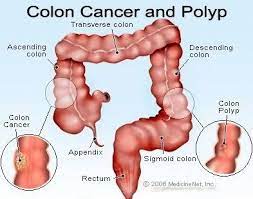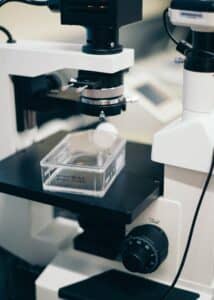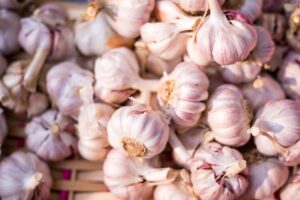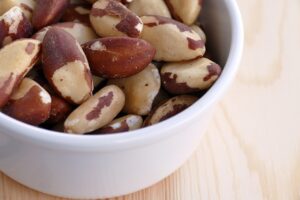Colorectal cancer is defined as any malignant neoplasm arising from the inner lining of the colonic epithelium. It is a cancer that starts in the colon or the rectum. It is the third most common cancer and the third leading cause of cancer-related deaths for men and women in the United States. The five-year survival rate of colon cancer after diagnosis at an early and localized stage is 90%. However, when distant metastasis has occurred, the five-year survival rate drops to 10%.
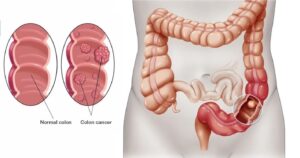
Colon cancer is mainly associated with Aberrant Crypt Foci (ACF) incidence. Neoplastic lesions are clusters of mucosal cells with an enlarged and thicker layer of epithelia than the surrounding normal crypts. They progress into polyps, followed by adenomas and adenocarcinomas. These event sequences result from accumulating multiple genetic alterations in the colon. Aberrant Crypt Foci are the microscopic precursors that doctors use to test for colorectal cancer.
How Lifestyle Can Explain Your Chances Of Cancer
Colon cancer is strongly related to age, with 90% of the cases arising in people 50 or older. The current estimate proves that 70-90% of colon cancer deaths have a link to diet. Only 5-10% of all cancer cases have an attribution to genetic defects. The remaining 90-95% have their roots in the environment and lifestyle. Furthermore, the estimate is that 75-85% of all chronic illnesses and diseases have links to overall patient lifestyle. Differences in genetic makeup cannot explain them.
The lifestyle factors include cigarette smoking, diet (fried foods, red meat, etc.), alcohol use, environmental pollutants, infections, stress, obesity, and a lack of physical inactivity. The evidence indicates that of all cancer-related deaths, as exposure, as many as 30–35% are linked to diet. Therefore, cancer prevention requires increased ingestion of fruit and vegetables, moderate intake of alcohol, caloric restriction, exercise, avoidance of direct exposure to sunlight, minimal meat consumption, and a diet containing whole grains. There is a positive association between fat and red meat and an inverse association between dietary fiber, fruit, and vegetable intake and the development of colorectal adenomas.
How Does A Healthy Diet Affect Cancer Cells
Many people want to know how a healthy diet decreases the spread of colon cancer. Recently, there has been considerable interest in using dietary prevention and chemoprevention to decrease colorectal cancer mortality. The recommendation is to eat more fruit and vegetables when working to prevent cancer. But, we have less understanding of the active ingredients and mechanisms of action. If you have a history of colon cancer in your family, the science recommends cutting out unhealthy food for your colon.
Extensive research has given an identity to various molecular targets that can potentially find use in cancer prevention and treatment. However, the lack of desirable therapeutic effects with targeted therapies has forced researchers to employ a combination of therapies that interfere with cancer cell growth.
The active components of dietary fruit and vegetables that have exhibited significant anticancer effects, including genistein, resveratrol, diallyl sulfide, S-allyl cysteine, allicin, lycopene, capsaicin, diosgenin, 6-gingerol, ellagic acid, ursolic acid, silymarin, anethol, catechins, eugenol, isoeugenol, dithiolthiones, isothiocyanates, indole-3-carbinol, isoflavones, saponins, phytosterols, inositol hexaphosphate, vitamin C, D-limonene, lutein, B-carotene, selenium, vitamin E, flavonoids and dietary fiber. These dietary agents can suppress the inflammatory processes that initiate and transform carcinogenesis, angiogenesis, and metastasis.
Major Oncogenic Pathways Targeted By Dietary Agents In Colorectal Cancer
Tumorigenesis is a multi-step process that can activate from various environmental carcinogens (such as cigarette smoke, industrial emissions, and gasoline vapors), inflammatory agents (such as tumor necrosis factor (TNF) and H₂O₂), and tumor promoters (such as phorbol esters and okadaic acid). A wide variety of molecular targets activating by distinct stimuli have implications for the initiation and progression of colorectal cancer.
NF-KB Pathway
From research studies, it is now a fact that NF-KB consistently activates colon cancer and helps transition benign carcinomas toward a metastatic phenotype. Activating NF-KB also leads to resistance of colon cancer cells to chemotherapy. Free radicals, inflammatory stimuli, cytokines, carcinogens, tumor promoters, endotoxins, and y-radiation activate NF-KB. Several activated target genes are critical to establishing the early and late stages of aggressive cancers, including the expression of cyclin D1, apoptosis suppressor proteins such as Be 2 and Bct X, and those required for metastasis and angiogenesis. Dietary agents can suppress the induced activation of IKK that leads to the inhibition of TNF-dependent phosphorylation and degradation of IkBa and translocation of the p65. Overall modulation of IF-ki activation by various dietary agents suppresses tumor proliferation, metastasis, and angiogenesis in various tumor cells.
Signal Transducer and Activator of Transcription (STAT)
STAT is one of the members of a family of STAT transcription factors. The binding of growth factors or cytokines activates their receptor tyrosine kinase or receptor-associated tyrosine kinases that subsequently phosphorylate the cytoplasmic part of the receptor and provide docking sites for monomeric STAT. Once recruited, STAT is phosphorylated on a specific tyrosine-705 residue, allowing its dimerization and translocation to the nucleus. STATS is linked to inflammation-associated tumorigenesis.
In addition, elevated STAT activity has been detected in various cancers. Moreover, the role of STAT is implicated in intestinal inflammation and colon cancer.32 Consistent with its role in various cancers, STAT regulates various genes involved in cancer progression, such as c-myc, cyclin D3, cyclin A, cdc25a, p21, cyclin D1, Pim-1, and Pim-2. Genes regulated by STAT involved in survival include proteins belonging to the family of Bcl-2 and IAPs, namely, Bcl-2, Bcl-x, Mcl-1, and survivin. VEGF regulates STAT-mediated angiogenesis and can also control the expression of various MMP family members, such as MMP2 and MMP9, that play an important role in tumor invasion and metastasis. Thus, various dietary agents also exert their anticancer effects by suppressing STAT and its regulated oncogenic gene products in colorectal cancer.
Reported Anticancer Effects Of Dietary Agents Against Colorectal Cancer
In this blog post section, we briefly discuss the fruit and vegetables that have shown significant potential in preventing and treating colorectal cancer. Starting with green tea. Green tea polyphenols such as epigallocatechin-3-gallate (EGCG) inhibit the creating of dangerous cells. EGCG, a major component in green tea polyphenols, has been reported to suppress colonic tumorigenesis in animal models and epidemiological studies. These dietary agents can find a use in either their natural form for prevention or perhaps in their pure form for therapy, where it may require large doses. EGCG treatment of human colorectal carcinoma HII-29 cells resulted in classical features of apoptosis, including nuclear condensation, DNA fragmentation, caspase activation, disruption of mitochondrial membrane potential, and cytochrome c release, which all appeared to be mediated by the c-Jun N-terminal kinase (INK) pathway.
Various fruits contain EGCG, including cranberries, strawberries, blackberries, kiwis, cherries, pears, peaches, apples, and avocados. EGCG can inhibit the growth and activation of signaling pathways in human colon cancer cells. EGCG can inhibit pathways, most likely through direct inhibition. In Asian countries with relatively lower incidences of colon cancer, such as China, Japan and Korea, one of the prominent lifestyle habits is the daily consumption of green tea beverages by a large population. A single green tea can contain up to 200 mg of EGCG. As EGCG is retained in the gastrointestinal tract after drinking, this pharmacokinetics property gives it the potential to function as a chemopreventive agent against colon cancer.
Moreover, ingesting EGCG has been shown to inhibit HT-29 colon cancer cell growth and activate caspases. Activation of MAPKs has detection as an early signaling event elicited by EGCG.
Green Tea And The Effects On Slowing The Spread Of Colon Cancer Cells
Drinking green tea blocks the formation of dimethylhydrazine-induced colonic aberrant crypt foci, a precursor lesion of chemical-initiated colon cancer. In HT-29 cells, treatment with EGCG can increase protein levels of E-cadherin by 27% to 58%.
Moreover, combining anticancer drugs with green tea catechin synergistically induces apoptosis in human cancer cells, which inhibits tumor formation in mice. This enhances tumor growth inhibition in xenograft mouse models. The effects of combining EGCG and anticancer drugs have been studied, focusing on inhibiting cell growth and the induction of apoptosis. In one experiment, mice were fed a diet with 0.03% sulindac and took water containing 0.1% green tea extract for 10 weeks. All mice ingested about 5 mg of sulindac and 10 mg of green tea extract. At 16 weeks, the average number of tumors per mouse decreased when fed daily green tea extract.
In this group (without sulindac and green tea extract), sulindac alone, green tea extract alone, and the combination (sulindac and green tea extract) showed a decrease of 55.7% of the average number of tumors per mouse in the combination group. Histologically, the control group produced 10.8% adenocarcinomas, whereas the groups treated with the combination of sulindac and green tea extract induced only adenomas. Moreover, mice treated with the combination showed an increase in body weight, as did those treated with sulindac alone and green tea extract alone, indicating that the treatment with the combination did not have any toxic effects.
Resveratrol
Resveratrol (3,5,4′-trihydroxystilbene), is a phytoalexin that you locate in grapes. Research shows it to have cancer chemopreventive properties. However, the mechanism of the anticarcinogenic activity is just starting to be the focus of studies. The absorption rate of resveratrol in the suppling the small intestine of the rat with an estimation to be only 20.5%. Therefore, the intestinal epithelium might be confronted with much higher concentrations than cells in other tissues.
Resveratrol will likely have an important role in preventing colon cancer by blocking hyperproliferation of the epithelium and promoting apoptosis. Limited data in humans have revealed that resveratrol is pharmacologically quite safe. Therefore, it can be concluded that resveratrol has a high potential in preventing colorectal cancer.
Diosgenin
Diosgenin is a natural steroid saponin found in various plant sources, including wild yam and fenugreek. Research has suggested that diosgenin may have potential anti-proliferative effects in various cancer cells. One mechanism through which diosgenin exerts its anti-proliferative effects is by inducing cell cycle arrest.
Cell cycle arrest is a regulatory mechanism that prevents cells from progressing through the various phases of the cell cycle, such as G1, S, G2, and M phases. This arrest can prevent the uncontrolled proliferation of cancer cells, a hallmark of cancer. Diosgenin can target specific proteins and pathways involved in the cell cycle to induce this arrest. Here’s how it works:
- G1 Phase Arrest: Diosgenin can inhibit the activity of cyclin-dependent kinases (CDKs), particularly CDK4 and CDK6, which are essential for progression through the G1 phase of the cell cycle. By inhibiting these CDKs, diosgenin prevents retinoblastoma protein (pRB) phosphorylation, a key regulator of G1 to S phase transition. This leads to G1 phase arrest, preventing cells from entering the S phase and undergoing DNA synthesis.
- S Phase Arrest: Diosgenin can also affect the expression of proteins in DNA replication during the S phase. By disrupting the proper functioning of proteins like proliferating cell nuclear antigen (PCNA) and inhibiting DNA polymerase activity, diosgenin can induce S phase arrest.
- G2/M Phase Arrest: Some studies have suggested that diosgenin can induce G2/M phase arrest by interfering with the expression and activity of CDK1 (also known as cyclin-dependent kinase 1) and cyclin B1, which are crucial for the G2 to M phase transition. This arrest prevents cells from entering the mitotic phase, where they would divide.
Eugenol
Eugenol is a natural compound in honey and various plant extracts, including cloves and Magnoliae flos. It has been use in a variety of medicinal applications. The anticancer mechanism of eugenol works against colon cancer cells. The treatment with eugenol inhibited proliferation and induced apoptosis in colon cancer cells. Studies suggest that eugenol can act as an anticancer agent against colon cancer.
Silibinin
Silibinin from milk thistle suppresses intestinal carcinogenesis. The treatment with commercial diosgenin or sanyaku (which contained diosgenin) in the diet for 17 weeks. Compared with the control, the result was a significant decrease in colonic mucosal ulcers, dysplastic crypts, and colon tumors.
Silibinin has been studied for its potential anti-cancer effects, particularly in certain types of cancer, such as prostate, breast, and skin cancer. Studies are investigating the effects of long-term (several weeks to months) oral administration of silibinin in cancer treatment protocols. However, the specific duration and dosage can vary based on the type and stage of cancer and the individual patient.
Capsaicin
Capsaicin (N-vanillyl-8-methyl-alpha-nonenamide), a spicy hot pepper component, is a homovanillic acid derivative that induces certain cancer cells to apoptosis. This element has a reputation in cancer chemoprevention. Thus, capsaicin has a beneficial effect on the treatment of colon cancer. A study also found that capsaicin suppressed the transcriptional activity of B-catenin/ICF. Capsaicin treatment resulted in a decrease in intracellular B-catenin levels and a reduction of transcripts from the B-catenin gene (CTNNB1).
In addition, capsaicin decreases levels of anti-apoptotic proteins. Increasing the levels of pro-apoptotic proteins such as apoptosis regulator BAX. Capsaicin induced apoptosis in Colo 205 cells by activating caspases 3, 8, and 9. In vivo studies in immunodeficient mice showed capsaicin effectively inhibited tumor growth. The potent in vitro and in vivo antitumor activities of capsaicin suggest that the development of capsaicin for treating human colon cancer looks promising.
Fisetin
Fisetin is indeed a naturally occurring flavonoid that you can find in various fruit and vegetables. It is known for its potential health benefits due to its antioxidant and anti-inflammatory properties. Here are some details about fisetin and its food sources:
Sources of Fisetin: Fisetin is an ingredient in a variety of plant-based foods, including:
-
- Onions: Onions, especially red onions, are one of the richest sources of fisetin.
- Cucumbers: Cucumbers contain moderate levels of fisetin.
- Apples: Apples, particularly the skins, contain fisetin.
- Persimmons: Persimmons are another fruit that contains fisetin.
- Strawberries: Strawberries have a relatively high fisetin content.
Fisetin has been studied for its impact on mitochondrial function and health. Some research suggests that fisetin may have antioxidant properties, which can help protect mitochondria from oxidative damage. Mitochondria are the “powerhouses” of the cell because they play a crucial role in generating energy through oxidative phosphorylation. This process occurs inside the mitochondrial membrane. The integrity of the mitochondrial membrane is essential for this process.
Fruit
Blackberries, black raspberries, blueberries, cranberries, red raspberries, and strawberry extracts have proof that they inhibit growth and stimulate apoptosis in HT-29 and HCT-116 cells. Cranberry fruit is high in the content of phenolic compounds, flavonoids, catechins, and flavanols.
Previously, grape seed extract treatment has proof to inhibit HI-29 cell growth by inducing GI phase cell cycle arrest. Pomegranates (Punica granatum) are small plants that farmers are cultivating in Afghanistan, India, Iran, Japan, China, Russia, and parts of the United States. In a study of rats given access to 20% pomegranate fruit juice before and after treatment with a colon-specific chemical carcinogen. After the seventeenth week of treatment, the rat colons show decreasing crypts in pomegranate juice-fed rats. Compared to other fruit juices, pomegranate juice was superior to other fruit juices as an inhibitor of aberrant crypt foci in a rat colon. In addition, the treatment with pomegranate fruit juice showed weight gain and increased animal feed intake. Suggesting a possible protective effect against cancer.
Diallyl Sulfide
Diallyl sulfide is a sulfur-containing compound found in garlic (Allium sativum) and other Allium vegetables, such as onions and shallots. It is a member of a group of organosulfur compounds that give these vegetables their characteristic pungent odor and taste. Diallyl sulfide is one of the key bioactive compounds responsible for many potential health benefits of garlic consumption.
Garlic effects come through multiple mechanisms. They include modulation of carcinogen metabolism, inhibition of DNA adduct formation, upregulation of antioxidant defenses, and DNA repair systems. Research on diallyl sulfide, an organosulphur component of garlic, proves cell cycle arrest. Administration of diallyl sulfide decreased the incidence of colonic polyps dose-dependently by 19% and 32% compared to the control animals. These results suggest that diallyl sulfide may have a high potential in preventing and treating colon cancer.
Apigenin
Apigenin is chemically known as 4,5,7-trihydroxyflavone, with the molecular formula GisHoO. This chemical compound is abundant in common fruit, such as oranges, pineapple, and grapefruit. Plant-derived beverages, such as tea. Vegetables, such as parsley and onions. Also, chamomile, wheat sprouts, and some seasonings?
Epidemiologic studies suggest that a diet rich in flavones is related to a decreased risk of certain cancers. Particularly cancers of the breast, digestive tract, skin, prostate, and certain hematological malignancies. The results support the findings that a high intake of flavonoids from fruit and vegetables has a direct association with halting the spread of cancer.
In various human colon carcinoma cell lines, apigenin treatment resulted in cancer cell growth inhibition and G2/M cell cycle arrest. An important effect of apigenin is its ability to increase the stability of the tumor suppressor. Exposure of p53 mutant cancer cells to apigenin inhibited cell growth and altered the cell cycle. This demonstration is in a study where apigenin treatment results in growth inhibition and G2/M phase arrest in two p53 mutant cancer cell lines. These results suggest a p53-independent pathway for apigenin in p53 mutant cell lines, which induces growth inhibition.
Delphinidin
Delphinidin, is the major anthocyanidin in vegetables such as eggplants, tomatoes, carrots, purple sweet potatoes, red cabbages, and red onions. It has been studied for many years due to its strong antioxidant and anti-inflammatory properties. Treatment with delphinidin in HCT-116 cells resulted in a decrease in cancer cell viability. Recent studies have also shown that the delphinidin compound reduces colon cancer cells in experimental conditions. Overall, these studies illustrate the anticancer potential of delphinidin against colon cancer and its mechanisms of action.
Conclusion
Colorectal cancer remains a leading cause of cancer mortality worldwide, with few therapeutic options to combat this disease. Natural compounds from different sources, such as fruits, vegetables, herbs, and fungi, open up novel and exciting perspectives on colorectal cancer prevention and treatment. However, much laboratory research remains about these agents’ molecular mechanisms, including their effects on genes overexpressed or mutated in carcinogenesis. Subsequent studies may increase our knowledge of whether these antioxidants can prevent colorectal cancer. These future studies should focus on molecular aspects of the antioxidant agents.
Animal and cell culture models in which oncogenes are overexpressed or tumor suppressor genes are silenced will provide important information. Thus, there is a great need for the development of novel and effective cancer therapies.

